FerricChlorideSolution MSDS三氯化铁溶液
- 格式:docx
- 大小:23.24 KB
- 文档页数:7
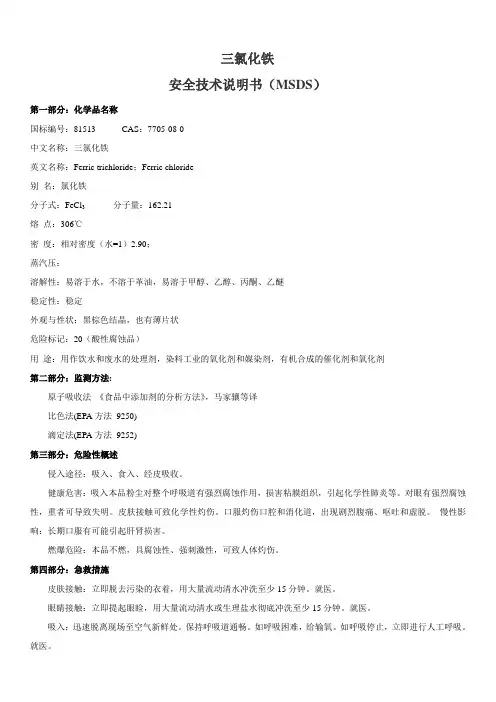
三氯化铁安全技术说明书(MSDS)第一部分:化学品名称国标编号:81513 CAS:7705-08-0中文名称:三氯化铁英文名称:Ferric trichloride;Ferric chloride别名:氯化铁分子式:FeCl3分子量:162.21熔点:306℃密度:相对密度(水=1)2.90;蒸汽压:溶解性:易溶于水,不溶于革油,易溶于甲醇、乙醇、丙酮、乙醚稳定性:稳定外观与性状:黑棕色结晶,也有薄片状危险标记:20(酸性腐蚀品)用途:用作饮水和废水的处理剂,染料工业的氧化剂和媒染剂,有机合成的催化剂和氧化剂第二部分:监测方法:原子吸收法《食品中添加剂的分析方法》,马家骧等译比色法(EPA方法9250)滴定法(EPA方法9252)第三部分:危险性概述侵入途径:吸入、食入、经皮吸收。
健康危害:吸入本品粉尘对整个呼吸道有强烈腐蚀作用,损害粘膜组织,引起化学性肺炎等。
对眼有强烈腐蚀性,重者可导致失明。
皮肤接触可致化学性灼伤。
口服灼伤口腔和消化道,出现剧烈腹痛、呕吐和虚脱。
慢性影响:长期口服有可能引起肝肾损害。
燃爆危险:本品不燃,具腐蚀性、强刺激性,可致人体灼伤。
第四部分:急救措施皮肤接触:立即脱去污染的衣着,用大量流动清水冲洗至少15分钟。
就医。
眼睛接触:立即提起眼睑,用大量流动清水或生理盐水彻底冲洗至少15分钟。
就医。
吸入:迅速脱离现场至空气新鲜处。
保持呼吸道通畅。
如呼吸困难,给输氧。
如呼吸停止,立即进行人工呼吸。
就医。
食入:用水漱口,给饮牛奶或蛋清。
就医。
第五部分:消防措施危险特性:受高热分解产生有毒的腐蚀性烟气。
有害燃烧产物:氯化物。
灭火方法:采用水、泡沫、二氧化碳灭火。
第六部分:泄漏应急处理应急处理:隔离泄漏污染区,限制出入。
建议应急处理人员戴防尘面具(全面罩),穿防毒服。
不要直接接触泄漏物。
小量泄漏:用洁净的铲子收集于干燥、洁净、有盖的容器中。
也可以用大量水冲洗,洗水稀释后放入废水系统。
大量泄漏:用塑料布、帆布覆盖。
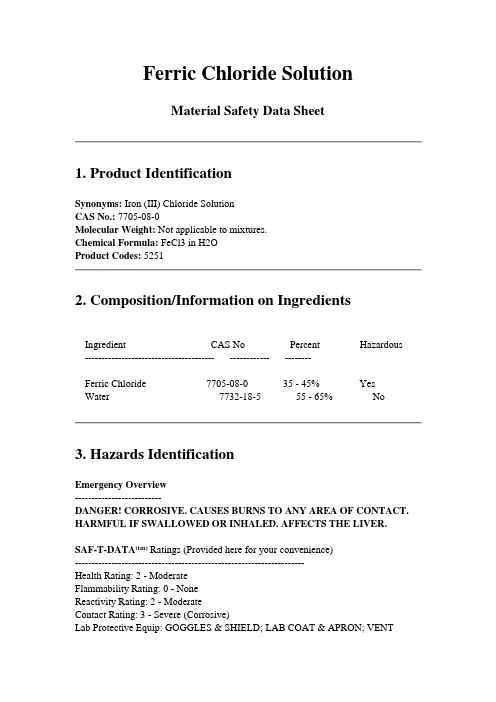
Ferric Chloride SolutionMaterial Safety Data Sheet1. Product IdentificationSynonyms: Iron (III) Chloride SolutionCAS No.: 7705-08-0Molecular Weight: Not applicable to mixtures.Chemical Formula: FeCl3 in H2OProduct Codes: 52512. Composition/Information on IngredientsIngredient CAS No Percent Hazardous --------------------------------------- ------------ --------Ferric Chloride 7705-08-0 35 - 45% YesWater 7732-18-5 55 - 65% No3. Hazards IdentificationEmergency Overview--------------------------DANGER! CORROSIVE. CAUSES BURNS TO ANY AREA OF CONTACT. HARMFUL IF SWALLOWED OR INHALED. AFFECTS THE LIVER. SAF-T-DATA(tm) Ratings (Provided here for your convenience)---------------------------------------------------------------------Health Rating: 2 - ModerateFlammability Rating: 0 - NoneReactivity Rating: 2 - ModerateContact Rating: 3 - Severe (Corrosive)Lab Protective Equip: GOGGLES & SHIELD; LAB COAT & APRON; VENTHOOD; PROPER GLOVESStorage Color Code: White (Corrosive)---------------------------------------------------------------------Potential Health Effects----------------------------------Inhalation:Extremely destructive to tissues of the mucous membranes and upper respiratory tract. Symptoms may include burning sensation, coughing, wheezing, laryngitis, shortness of breath, headache, nausea and vomiting.Ingestion:Corrosive. Swallowing can cause severe burns of the mouth, throat, and stomach. Can cause sore throat, vomiting, diarrhea. Low systemic toxicity in small quantities but larger doses may cause systemic effects. Pink urine discoloration is a strong indicator of iron poisoning. Liver damage, coma and death may follow, sometimes delayed as long as three days.Skin Contact:Corrosive. Symptoms of redness, pain, and severe burn can occur.Eye Contact:Corrosive. Contact can cause blurred vision, redness, pain and severe tissue burns. Chronic Exposure:Repeated ingestion may cause liver damage. Prolonged exposure of the eyes may cause discoloration.Aggravation of Pre-existing Conditions:No information found.4. First Aid MeasuresInhalation:Remove to fresh air. If not breathing, give artificial respiration. If breathing is difficult, give oxygen. Get medical attention immediately.Ingestion:If swallowed, DO NOT INDUCE VOMITING. Give large quantities of water. Never give anything by mouth to an unconscious person. Get medical attention immediately. Skin Contact:Immediately flush skin with plenty of water for at least 15 minutes while removing contaminated clothing and shoes. Get medical attention immediately. Wash clothing before reuse. Thoroughly clean shoes before reuse.Eye Contact:Immediately flush eyes with plenty of water for at least 15 minutes, lifting lower and upper eyelids occasionally. Get medical attention immediately.5. Fire Fighting MeasuresFire:Not considered to be a fire hazard. Irritating hydrogen chloride fumes may form in fire.Explosion:Not considered to be an explosion hazard.Fire Extinguishing Media:Water, dry chemical, foam or carbon dioxide. Do not allow water runoff to enter sewers or waterways.Special Information:In the event of a fire, wear full protective clothing and NIOSH-approvedself-contained breathing apparatus with full facepiece operated in the pressure demand or other positive pressure mode.6. Accidental Release MeasuresVentilate area of leak or spill. Wear appropriate personal protective equipment as specified in Section 8. Isolate hazard area. Keep unnecessary and unprotected personnel from entering. Contain and recover liquid when possible. Collect liquid in an appropriate container or absorb with an inert material (e. g., vermiculite, dry sand, earth), and place in a chemical waste container. Do not use combustible materials, such as saw dust. Do not flush to sewer!7. Handling and StorageKeep in a tightly closed container, stored in a cool, dry, ventilated area. Protect against physical damage. Isolate from incompatible substances. Containers of this material are hazardous when empty since they retain product residues; observe all warnings for the product.8. Exposure Controls/Personal ProtectionAirborne Exposure Limits:-ACGIH Threshold Limit Value (TLV):1 mg/m3 (TWA) soluble iron salt as FeVentilation System:A system of local and/or general exhaust is recommended to keep employee exposures below the Airborne Exposure Limits. Local exhaust ventilation is generally preferred because it can control the emissions of the contaminant at its source, preventing dispersion of it into the general work area. Please refer to the ACGIH document, Industrial Ventilation, A Manual of Recommended Practices, most recent edition, for details.Personal Respirators (NIOSH Approved):If the exposure limit is exceeded and engineering controls are not feasible, a full facepiece particulate respirator (NIOSH type N100 filters) may be worn for up to 50 times the exposure limit or the maximum use concentration specified by the appropriate regulatory agency or respirator supplier, whichever is lowest. If oil particles (e.g. lubricants, cutting fluids. glycerine, etc.) are present, use a NIOSH type R or P filter. For emergencies or instances where the exposure levels are not known, use a full-facepiece positive-pressure, air-supplied respirator. WARNING:Air-purifying respirators do not protect workers in oxygen-deficient atmospheres. Skin Protection:Wear impervious protective clothing, including boots, gloves, lab coat, apron or coveralls, as appropriate, to prevent skin contact.Eye Protection:Use chemical safety goggles and/or a full face shield where splashing is possible. Maintain eye wash fountain and quick-drench facilities in work area.9. Physical and Chemical PropertiesAppearance:Orange to brown liquid.Odor:Acid odor.Solubility:Complete (100%)Specific Gravity:1.40pH:No information found.% Volatiles by volume @ 21C (70F):55-65Boiling Point:230C (446F)Melting Point:No information found.Vapor Density (Air=1):No information found.Vapor Pressure (mm Hg):No information found.Evaporation Rate (BuAc=1):No information found.10. Stability and ReactivityStability:Stable under ordinary conditions of use and storage.Hazardous Decomposition Products:May produce hydrogen chloride.Hazardous Polymerization:This substance does not polymerize.Incompatibilities:Metals, allyl chloride, sodium, potassium.Conditions to Avoid:Incompatibles.11. Toxicological InformationOral rat LD50: 316 mg/kg (anhydrous); investigated as a mutagen, reproductive effector.--\CancerLists\---------------------------------------------------------NTP Carcinogen---Ingredient Known Anticipated IARC Category ------------------------------------ ----- ----------- -------------Ferric Chloride (7705-08-0) No No None Water (7732-18-5) No No None 12. Ecological InformationEnvironmental Fate:No information found.Environmental Toxicity:No information found.13. Disposal ConsiderationsWhatever cannot be saved for recovery or recycling should be managed in an appropriate and approved waste facility. Although not a listed RCRA hazardous waste, this material may exhibit one or more characteristics of a hazardous waste and require appropriate analysis to determine specific disposal requirements. Processing, use or contamination of this product may change the waste management options. State and local disposal regulations may differ from disposal regulations. Dispose of container and unused contents in accordance with state and local requirements.14. Transport InformationNot regulated.15. Regulatory Information-\Chemical Inventory Status - Part 1\--------------------------------Ingredient TSCA EC Japan Australia----------------------------------------------- ---- --- -----Ferric Chloride (7705-08-0) Yes Yes Yes YesWater (7732-18-5) Yes Yes Yes Yes\Chemical Inventory Status - Part 2\-----------------------------------Canada-- Ingredient Korea DSL NDSL China. ----------------------------------------------- ----- --- ----Ferric Chloride (7705-08-0) Yes Yes No Yes Water (7732-18-5) Yes Yes No Yes-\China & International Regulations - Part 1\-----------------SARA 302- ------SARA 313------ Ingredient RQ TPQ List Chemical Catg.----------------------------------------- --- ----- ----Ferric Chloride (7705-08-0) No No No NoWater (7732-18-5) No No No No\China & International Regulations - Part 2\-----------------RCRA- -TSCA-Ingredient CERCLA 261.33 8(d)----------------------------------------- ------ ------ --Ferric Chloride (7705-08-0) 1000 No NoWater (7732-18-5) No No NoChemical Weapons Convention: No TSCA 12(b): No CDTA: No SARA 311/312: Acute: Yes Chronic: Yes Fire: No Pressure: No Reactivity: No (Mixture / Liquid)Australian Hazchem Code: None allocated.Poison Schedule: None allocated.WHMIS:This MSDS has been prepared according to the hazard criteria of the Controlled Products Regulations (CPR) and the MSDS contains all of the information requiredby the CPR.16. Other InformationNFPA Ratings: Health: 3 Flammability: 0 Reactivity: 0Label Hazard Warning:DANGER! CORROSIVE. CAUSES BURNS TO ANY AREA OF CONTACT. HARMFUL IF SWALLOWED OR INHALED. AFFECTS THE LIVER.Label Precautions:Do not get in eyes, on skin, or on clothing.Do not breathe mist.Keep container closed.Use only with adequate ventilation.Wash thoroughly after handling.Label First Aid:In case of contact, immediately flush eyes or skin with plenty of water for at least 15 minutes while removing contaminated clothing and shoes. Wash clothing before reuse. If inhaled, remove to fresh air. If not breathing, give artificial respiration. If breathing is difficult, give oxygen. If swallowed, DO NOT INDUCE VOMITING. Give large quantities of water. Never give anything by mouth to an unconscious person. In all cases get medical attention immediately.Product Use:Laboratory Reagent.Revision Information:MSDS Section(s) changed since last revision of document include: 3.。
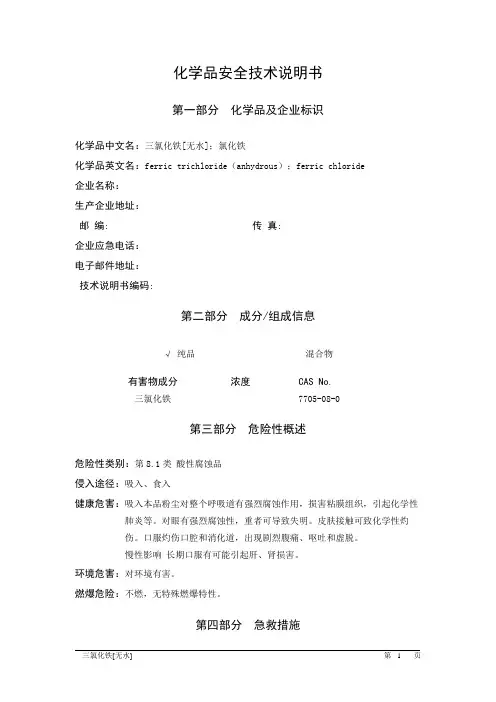
化学品安全技术说明书第一部分化学品及企业标识化学品中文名:三氯化铁[无水];氯化铁化学品英文名:ferric trichloride(anhydrous);ferric chloride企业名称:生产企业地址:邮编: 传真:企业应急电话:电子邮件地址:技术说明书编码:第二部分成分/组成信息√纯品混合物有害物成分浓度CAS No.三氯化铁7705-08-0第三部分危险性概述危险性类别:第8.1类酸性腐蚀品侵入途径:吸入、食入健康危害:吸入本品粉尘对整个呼吸道有强烈腐蚀作用,损害粘膜组织,引起化学性肺炎等。
对眼有强烈腐蚀性,重者可导致失明。
皮肤接触可致化学性灼伤。
口服灼伤口腔和消化道,出现剧烈腹痛、呕吐和虚脱。
慢性影响长期口服有可能引起肝、肾损害。
环境危害:对环境有害。
燃爆危险:不燃,无特殊燃爆特性。
第四部分急救措施皮肤接触:立即脱去污染的衣着,用大量流动清水冲洗20~30分钟。
如有不适感,就医。
眼睛接触:立即提起眼睑,用大量流动清水或生理盐水彻底冲洗10~15分钟。
如有不适感,就医。
吸入:迅速脱离现场至空气新鲜处。
保持呼吸道通畅。
如呼吸困难,给输氧。
呼吸、心跳停止,立即进行心肺复苏术。
就医。
食入:用水漱口,给饮牛奶或蛋清。
就医。
第五部分消防措施危险特性:受高热分解产生有毒的腐蚀性烟气。
有害燃烧产物:无意义。
灭火方法:用水、泡沫、二氧化碳灭火。
灭火注意事项及措施:消防人员必须佩戴空气呼吸器、穿全身防火防毒服,在上风向灭火。
尽可能将容器从火场移至空旷处。
喷水保持火场容器冷却,直至灭火结束。
第六部分泄漏应急处理应急行动:隔离泄漏污染区,限制出入。
建议应急处理人员戴防尘口罩,穿防酸碱服。
作业时使用的所有设备应接地。
穿上适当的防护服前严禁接触破裂的容器和泄漏物。
尽可能切断泄漏源。
小量泄漏:用干燥的砂土或其它不燃材料覆盖泄漏物,然后用塑料布覆盖,减少飞散、避免雨淋。
用洁净的铲子收集泄漏物,置于干净、干燥、盖子较松的容器中,将容器移离泄漏区。

化学品安全技术说明书第一部分化学品及企业标识化学品中文名:三氯化铁[无水];氯化铁化学品英文名:ferric trichloride(anhydrous);ferric chloride企业名称:生产企业地址:邮编: 传真:企业应急电话:电子邮件地址:技术说明书编码:第二部分成分/组成信息√纯品混合物有害物成分浓度CAS No.三氯化铁7705-08-0第三部分危险性概述危险性类别:第8.1类酸性腐蚀品侵入途径:吸入、食入健康危害:吸入本品粉尘对整个呼吸道有强烈腐蚀作用,损害粘膜组织,引起化学性肺炎等。
对眼有强烈腐蚀性,重者可导致失明。
皮肤接触可致化学性灼伤。
口服灼伤口腔和消化道,出现剧烈腹痛、呕吐和虚脱。
慢性影响长期口服有可能引起肝、肾损害。
环境危害:对环境有害。
燃爆危险:不燃,无特殊燃爆特性。
第四部分急救措施皮肤接触:立即脱去污染的衣着,用大量流动清水冲洗20~30分钟。
如有不适感,就医。
眼睛接触:立即提起眼睑,用大量流动清水或生理盐水彻底冲洗10~15分钟。
如有不适感,就医。
吸入:迅速脱离现场至空气新鲜处。
保持呼吸道通畅。
如呼吸困难,给输氧。
呼吸、心跳停止,立即进行心肺复苏术。
就医。
食入:用水漱口,给饮牛奶或蛋清。
就医。
第五部分消防措施危险特性:受高热分解产生有毒的腐蚀性烟气。
有害燃烧产物:无意义。
灭火方法:用水、泡沫、二氧化碳灭火。
灭火注意事项及措施:消防人员必须佩戴空气呼吸器、穿全身防火防毒服,在上风向灭火。
尽可能将容器从火场移至空旷处。
喷水保持火场容器冷却,直至灭火结束。
第六部分泄漏应急处理应急行动:隔离泄漏污染区,限制出入。
建议应急处理人员戴防尘口罩,穿防酸碱服。
作业时使用的所有设备应接地。
穿上适当的防护服前严禁接触破裂的容器和泄漏物。
尽可能切断泄漏源。
小量泄漏:用干燥的砂土或其它不燃材料覆盖泄漏物,然后用塑料布覆盖,减少飞散、避免雨淋。
用洁净的铲子收集泄漏物,置于干净、干燥、盖子较松的容器中,将容器移离泄漏区。
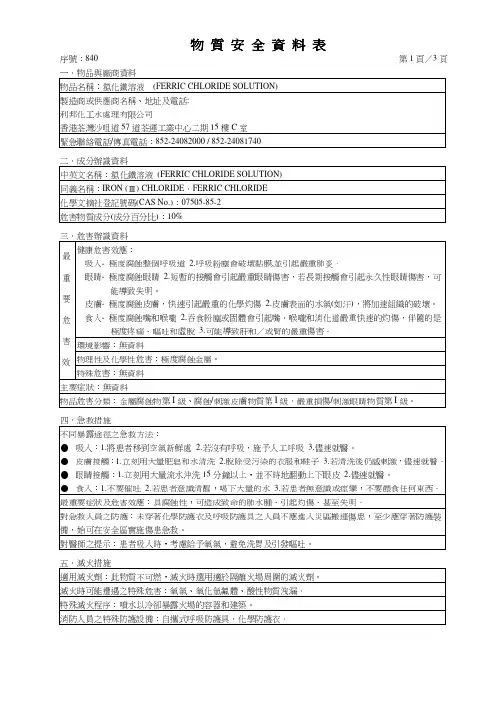
一、物品與廠商資料物品名稱:氯化鐵溶液 (FERRIC CHLORIDE SOLUTION) 製造商或供應商名稱、地址及電話:利邦化工水處理有限公司香港荃灣沙咀道57道荃運工業中心二期15樓C室緊急聯絡電話/傳真電話:852-******** / 852-********二、成分辦識資料中英文名稱:氯化鐵溶液(FERRIC CHLORIDE SOLUTION) 同義名稱:IRON (Ⅲ) CHLORIDE、FERRIC CHLORIDE化學文摘社登記號碼(CAS No.):07505-85-2危害物質成分(成分百分比):10%三、危害辦識資料最重要危害效健康危害效應:吸入- 極度腐蝕整個呼吸道2.呼吸粉塵會破壞黏膜,並引起嚴重肺炎。
眼睛- 極度腐蝕眼睛2.短暫的接觸會引起嚴重眼睛傷害,若長期接觸會引起永久性眼睛傷害,可能導致失明。
皮膚- 極度腐蝕皮膚,快速引起嚴重的化學灼傷2.皮膚表面的水氣(如汗),將加速組織的破壞。
食入- 極度腐蝕嘴和喉嚨2.吞食粉塵或固體會引起嘴、喉嚨和消化道嚴重快速的灼傷,伴隨的是極度疼痛、嘔吐和虛脫3.可能導致肝和/或腎的嚴重傷害。
環境影響:無資料物理性及化學性危害:極度腐蝕金屬。
特殊危害:無資料主要症狀:無資料物品危害分類:金屬腐蝕物第I級、腐蝕/刺激皮膚物質第I級、嚴重損傷/刺激眼睛物質第I級。
四、急救措施不同暴露途徑之急救方法:● 吸入:1.將患者移到空氣新鮮處2.若沒有呼吸,施予人工呼吸3.儘速就醫。
● 皮膚接觸:1.立刻用大量肥皂和水清洗2.脫除受污染的衣服和鞋子3.若清洗後仍感剌激,儘速就醫。
● 眼睛接觸:1.立刻用大量流水沖洗15分鐘以上,並不時地翻動上下眼皮2.儘速就醫。
● 食入:1.不要催吐2.若患者意識清醒,喝下大量的水3.若患者無意識或痙攣,不要餵食任何東西。
最重要症狀及危害效應:具腐蝕性,可造成致命的肺水腫、引起灼傷、甚至失明。
對急救人員之防護:未穿著化學防護衣及呼吸防護具之人員不應進入災區搬運傷患,至少應穿著防護裝備,始可在安全區實施傷患急救。
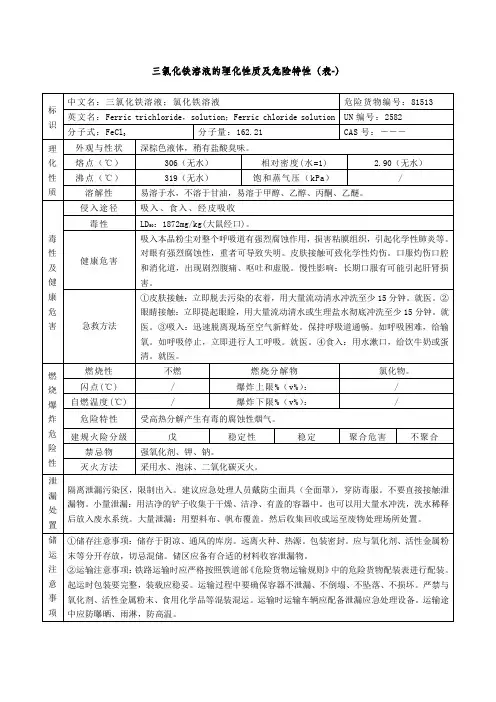
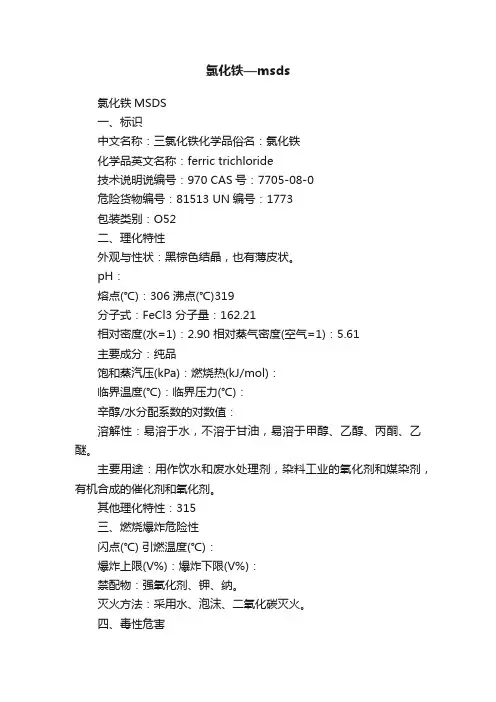
氯化铁—msds氯化铁MSDS一、标识中文名称:三氯化铁化学品俗名:氯化铁化学品英文名称:ferric trichloride技术说明说编号:970 CAS号:7705-08-0危险货物编号:81513 UN编号:1773包装类别:O52二、理化特性外观与性状:黑棕色结晶,也有薄皮状。
pH:熔点(℃):306 沸点(℃)319分子式:FeCl3 分子量:162.21相对密度(水=1):2.90 相对蒸气密度(空气=1):5.61主要成分:纯品饱和蒸汽压(kPa):燃烧热(kJ/mol):临界温度(℃):临界压力(℃):辛醇/水分配系数的对数值:溶解性:易溶于水,不溶于甘油,易溶于甲醇、乙醇、丙酮、乙醚。
主要用途:用作饮水和废水处理剂,染料工业的氧化剂和媒染剂,有机合成的催化剂和氧化剂。
其他理化特性:315三、燃烧爆炸危险性闪点(℃) 引燃温度(℃):爆炸上限(V%):爆炸下限(V%):禁配物:强氧化剂、钾、纳。
灭火方法:采用水、泡沫、二氧化碳灭火。
四、毒性危害危险性类别:侵入途径:危险特性:受高热分解产生有毒的腐蚀性气体。
有害燃烧产物:氯化物健康危害:吸入本品粉尘对整个呼吸道有强烈的腐蚀作用,损害粘膜组织,引起化学性肺炎等。
对眼有强烈的腐蚀性,严重可导致失明。
皮肤接触可致化学灼伤。
口服灼伤口和消化道,出现剧烈腹痛、呕吐和虚脱。
慢性影响:长期口服有可能肝肾损害。
环境危害:燃爆危险:本品不燃,具有腐蚀性、强刺激性,可致人体灼伤。
五、急救措施皮肤接触:立即脱去污染的衣着,用大量的流动的清水冲洗至少15分钟。
就医。
眼睛接触:立即提起眼睑,用大量流动的清水或生理盐水冲洗至少15分钟。
就医。
吸入:迅速脱离现场至空气新鲜处。
保持呼吸道畅通。
如呼吸困难,给输氧。
如呼吸停止,立即进行人工呼吸。
就医。
食入:用水漱口,给牛奶或蛋清。
就医。
六、防护措施泄露处理:隔离污染区域,限制出入。
建议应急处理人员戴防尘面具(全面罩),穿防毒服。
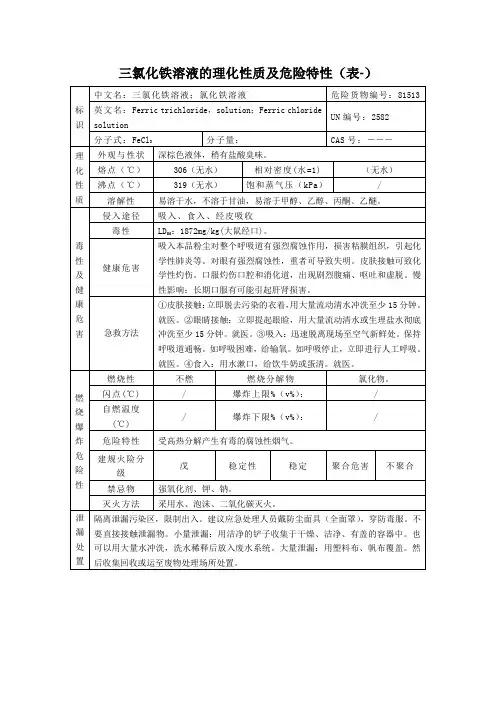
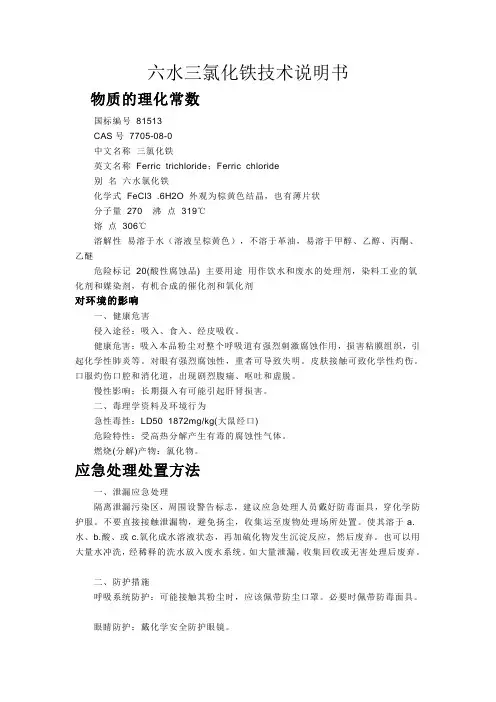
六水三氯化铁技术说明书物质的理化常数国标编号81513CAS号7705-08-0中文名称三氯化铁英文名称Ferric trichloride;Ferric chloride别名六水氯化铁化学式FeCl3 .6H2O 外观为棕黄色结晶,也有薄片状分子量270 沸点319℃熔点306℃溶解性易溶于水(溶液呈棕黄色),不溶于革油,易溶于甲醇、乙醇、丙酮、乙醚危险标记20(酸性腐蚀品) 主要用途用作饮水和废水的处理剂,染料工业的氧化剂和媒染剂,有机合成的催化剂和氧化剂对环境的影响一、健康危害侵入途径:吸入、食入、经皮吸收。
健康危害:吸入本品粉尘对整个呼吸道有强烈刺激腐蚀作用,损害粘膜组织,引起化学性肺炎等。
对眼有强烈腐蚀性,重者可导致失明。
皮肤接触可致化学性灼伤。
口服灼伤口腔和消化道,出现剧烈腹痛、呕吐和虚脱。
慢性影响:长期摄入有可能引起肝肾损害。
二、毒理学资料及环境行为急性毒性:LD50 1872mg/kg(大鼠经口)危险特性:受高热分解产生有毒的腐蚀性气体。
燃烧(分解)产物:氯化物。
应急处理处置方法一、泄漏应急处理隔离泄漏污染区,周围设警告标志,建议应急处理人员戴好防毒面具,穿化学防护服。
不要直接接触泄漏物,避免扬尘,收集运至废物处理场所处置。
使其溶于a.水、b.酸、或c.氧化成水溶液状态,再加硫化物发生沉淀反应,然后废弃。
也可以用大量水冲洗,经稀释的洗水放入废水系统。
如大量泄漏,收集回收或无害处理后废弃。
二、防护措施呼吸系统防护:可能接触其粉尘时,应该佩带防尘口罩。
必要时佩带防毒面具。
眼睛防护:戴化学安全防护眼镜。
防护服:穿工作服(防腐材料制作)。
手防护:戴橡皮手套。
其它:工作后,淋浴更衣。
单独存放被毒物污染的衣服,洗后再用。
保持良好的卫生习惯。
三、急救措施皮肤接触:立即用水冲洗至少15分钟。
若有灼伤,就医治疗。
眼睛接触:立即提起眼睑,用流动清水或生理盐水冲洗至少15分钟。
就医。
吸入:迅速脱离现场至空气新鲜处。

三氯化铁安全技术说明书 三氯化铁;三氯化铁ferric trichloride (anhydrous ); ferric chloride162.21 中文名 英文名[无水 ];氯化铁标 识分子式危规号 FeCl 3 分子量 UN 编号 CAS 号 815131773 RTECS 号 7705-08-0 黑棕色结晶,也有薄片状 主要组成熔点℃性状易溶于水,不溶于甘油,易溶于甲醇、乙醇、丙 酮、乙醚306319溶解性理 化 性相对密度 (水 =1) 沸点℃2.905.61质饱和蒸气压KPa 相对蒸气密度(空气 =1):5.61临界温 度℃ 无资料 燃烧热 无意义临界压力 MPa 最小引燃能 量 mJ 无资料 不燃无意义 氯化物燃燃烧性分解产物烧闪点℃ 无意义 无意义聚合危险 稳定性不聚合 稳定爆爆炸极 炸限% 危引燃温 强氧化剂、钾、钠无意义 禁忌物险 性度℃ 不燃,无特殊燃爆特性。
受高热分解产生有毒 的腐蚀性烟气。
危险特性消防人员必须佩戴空气呼吸器、穿全身防火防毒服,灭火方法 在上风向灭火。
尽可能将容器从火场移至空旷处。
喷水保持火场容器冷却,直至灭火结束。
灭火剂用水、泡沫、二氧化碳灭火急性毒性:对粘膜具有轻度刺激性和腐蚀性。
对家兔静注 的 LD毒为 7.2mg/kg 。
LD50:大鼠经口 LD50(mg/kg): 316小鼠经口 性 LD50(mg/kg): 200DNA 1刺激性:致突变性: 损伤:人类细胞umol/L/1H 。
对 吸入本品粉尘对整个呼吸道有强烈腐蚀作用,损害粘膜组织,引 起化学性肺炎等。
对眼有强烈腐蚀性,重者可导致失明。
皮肤接 触可致化学性灼伤。
口服灼伤口腔和消化道,出现剧烈腹痛、呕 吐和虚脱。
慢性影响 长期口服有可能引起肝、肾损害。
人 体 伤 害皮肤接触:立即脱去污染的衣着,用大量流动清水冲洗20~30 分钟。
如有不适感,就医。
眼睛接触:立即提起眼睑,用大量流动清水或生理盐水彻底冲洗急10~15分钟。
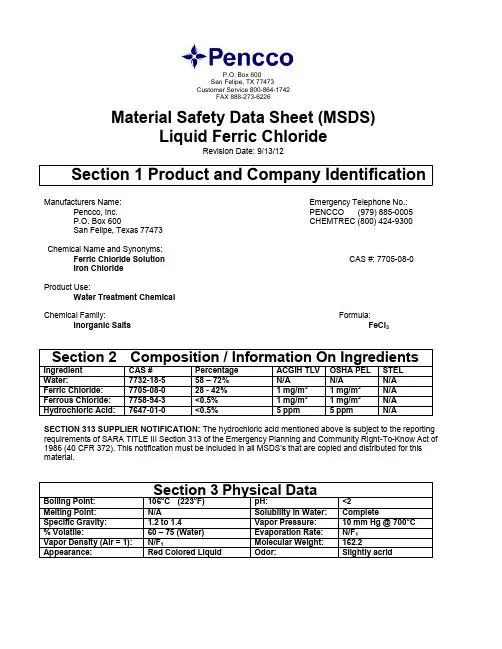
P.O. Box 600San Felipe, TX 77473Customer Service 800-864-1742FAX 888-273-6226Material Safety Data Sheet (MSDS)Liquid Ferric ChlorideRevision Date: 9/13/12Section 1 Product and Company Identification Manufacturers Name: Emergency Telephone No.: Pencco, Inc. PENCCO (979) 885-0005P.O. Box 600 CHEMTREC (800) 424-9300San Felipe, Texas 77473Chemical Name and Synonyms:Ferric Chloride Solution CAS #: 7705-08-0Iron ChlorideProduct Use:Water Treatment ChemicalChemical Family: Formula: Inorganic Salts FeCl3Section 2 Composition / Information On Ingredients Ingredient CAS #Percentage ACGIH TLV OSHA PEL STELWater:7732-18-558 – 72%N/A N/A N/AFerric Chloride:7705-08-028 - 42% 1 mg/m3 1 mg/m3N/AFerrous Chloride:7758-94-3<0.5% 1 mg/m3 1 mg/m3N/A Hydrochloric Acid:7647-01-0<0.5% 5 ppm 5 ppm N/A SECTION 313 SUPPLIER NOTIFICATION: The hydrochloric acid mentioned above is subject to the reporting requirements of SARA TITLE III Section 313 of the Emergency Planning and Community Right-To-Know Act of 1986 (40 CFR 372). This notification must be included in all MSDS’s that are copied and distributed for this material.Section 3 Physical DataBoiling Point:106o C (223o F)pH:<2Melting Point:N/A Solubility in Water:CompleteSpecific Gravity: 1.2 to 1.4Vapor Pressure:10 mm Hg @ 700o C% Volatile:60 – 75 (Water)Evaporation Rate:N/F1Vapor Density (Air = 1):N/F1Molecular Weight:162.2Appearance:Red Colored Liquid Odor:Slightly acridSection 4 Fire and Explosion DataFlash Point:N/A2Flammable Limits in Air:UEL: N/A2LEL: N/A2Special Fire and Explosion Hazards:Substance itself does notburn, but may decomposeupon heating to producecorrosive and/or toxicfumes.Extinguishing Media:Will not burn; Usematerials appropriatefor surrounding fire.Special Fire Fighting Instructions:Firefighters should wear proper protectiveequipment and self-contained breathingapparatus with full face piece operated in apositive pressure mode. Move exposedcontainers from fire area if it can be done withoutrisk. Use water to keep fire-exposed containersand tanks cool.Section 5 ReactivityDecomposition:Decompose uponheating to producecorrosive and/or toxicfumes.Polymerization:Will not OccurStability:StableIncompatibility:Rapidly corrodes most metals (titanium is one exception); may generateflammable, potentially explosive hydrogen gas. Avoid contact with nylon,aluminum/aluminum alloys, carbon steel, stainless steel, and copper /copper alloysSection 6 Health HazardsEmergency Overview: Harmful or fatal if swallowed. Harmful if inhaled. Eye or skin contact may cause irritation.Summary of Acute Health HazardsIngestion: This material is toxic by ingestion.Inhalation: May cause irritation of the upper respiratory tract.Skin: This product may cause irritation to the skin.Eyes: This product may cause irritation; repeated or prolonged exposure may cause conjunctivitis.Signs and Symptoms of Exposure: Repeated exposure to large amounts of Ferric Chloride may increase irritation.Effects of Overexposure: Symptoms of Ingestion: Abdominal pain and prolonged vomiting may begin up to one hour after ingestion of excessive quantities of soluble iron salts. Hematemesis, dehydration, shock, pallor, cyanosis, hypothermia, vasomotor instability, and coma may follow. If death is not immediate, it may occur 1-3 days later, survivors may develop reversible hemorrhagic necrosis. Gastric scarring may occur after 4 weeks. Pyloric stenosis and mild hepatic cirrhosis may persist.Toxic effects in animals from repeated exposure by ingestion include reduced weight gain, elevated serum iron levels, increased red blood cell counts, and iron deposition in many organs. Tests in bacterial and mammalian cell cultures demonstrate no genetic damage. Animal tests demonstrate no carcinogenicity.Human health effects of overexposure by eye contact may include discoloration of eye tissues, eye irritation and discomfort, tearing and blurring of vision, or eye corrosion with corneal or conjunctival ulceration. Skin contact may cause skin irritation with discomfort or rash, skin burns, or ulceration. Ferric chloride has been infrequently associated with skin sensitization in humans. Overexposure by inhalation may result in irritation of the upper respiratory passages with coughing. Ingestion may cause corrosive damage to the GI tract. Repeated ingestion of sublethal doses may lead to excessive deposition in the tissues accompanied by pancreatic and liver damage. Ingestion in higher doses may lead to abnormal liver function with nausea or vomiting, reduced appetite, abdominal pain, lethargy, tarry stools, diarrhea, fast and weak pulse, hypertension, dehydration acidosis, and coma. Temporary alteration of the heart's electrical activity may result in irregular pulse, palpitations, or inadequate circulation. If death does not occur immediately, symptoms may clear in a few hours but return within a day with cyanosis, pulmonary edema, shock, convulsions, acidosis, fever, and death.Individuals with pre-existing diseases of the liver may have increased susceptibility to the toxicity of repeated exposures.CARCINOGENICITY: None of the components of this material are listed as a carcinogen by IARC, NTP, OSHA, or ACGIH.Section 7 First AidEYE: Immediately flush eyes for 15 minutes with large amounts of water while holding eyelids apart. Washing within one minute is essential to achieve maximum effectiveness. Obtain medical attention immediately after flushing.SKIN: Flush skin with water. Remove contaminated clothing; wash before reuse. If irritation is still present, seek medical attention.INHALATION: Remove to fresh air. If not breathing, give artificial respiration. If breathing is difficult, give oxygen. Obtain medical attention immediately.INGESTION: DO NOT INDUCE VOMITING. Give 1 or 2 glasses of water or milk. Never give anything by mouth to an unconscious individual. Obtain medical attention immediately.Section 8 Personal ProtectionAdequate general ventilation should be provided to keep vapor and mists below exposure limits.Wear safety glasses with side shields. Wear a face shield if possibility of material splashing or spraying exists. Where there is possibility of skin contact, use the following as appropriate, to avoid skin contact: gloves impervious to material, apron, boots, hood, pants, and jacket. Wear a NIOSH/OSHA approved respirator with a dust/mist cartridge if there is potential of exposure to mists in excess of applicable limits, in any situation where product vapor or mists may be present, such as in confined spaces.An eye wash and safety shower should be readily accessible. Wash hands thoroughly after handling.Section 9 NFPA/HMIS RATINGSNFPA HMIS 4 = Extreme / Severe Health:22 3 = High / Serious Reactivity:00 2 = ModerateFlammability:00 1 = SlightSection 10 Spill/Leak ProcedureReview safety precautions before proceeding with cleanup. Use appropriate personal protection equipment. Neutralize spill with lime (calcium hydroxide), limestone (calcium carbonate), or soda ash (sodium carbonate).CAUTION: limestone and soda ash will evolve CO2; ventilation should be provided in enclosed areas. Dike area around spill to prevent spreading, and use absorbent material to pick up spill.CERCLA REPORTABLE DISCHARGE (RQ): 1000 lbs. (454 kg), Based on anhydrous ferric chloride. Divide by solution concentration to obtain solution weight.DISPOSAL: Under the Resource Conservation and Recovery Act (RCRA), it is the responsibility of the user to determine whether a substance should be classified as a hazardous waste at the time of disposal. This is due to the fact that product use, transformation, synthesis, mixtures, etc. may change the nature of the product. Dispose of waste in accordance with applicable federal, state, and local laws.RCRA: Test waste material for corrosivity, DOO2, prior to disposal.Steps To Be Taken In Case Material Is Released Or Spilled: Notify the appropriate environmental authorities. Note that spills may need to be reported to the National Response Center (800/ 424-8802) Section 11 Shipping InformationDOTProper Shipping Name:Ferric Chloride Solution Hazard Class:Class 8NA/UN#:UN 2582DOT Labels:CorrosivePackaging Group:Group III DOT Placards:CorrosiveIMOProper Shipping:Ferric Chloride Solution Hazard Class:Corrosive material, 8NA/UN#:UN 2582IMO Label:CorrosivePackaging Group:Group III Reportable Quantity:1000 lbs (454 kg)Shipping Containers:Rubber-lined steel tank cars/ trucks; polyethylene drums, bottlesStorage Conditions:Keep containers closedSection 12 SARA Title III Hazard ClassificationAcute:Yes Chronic:NoFire:No Reactivity:NoPressure:No Toxic Chemical:NoEFlammability:0Canadian WHMISClassification:Extremely Hazardous Substance:NoCERCLA Hazardous Substance:YesSection 13 Additional Information and References IMPORTANT!! Read this MSDS before use or disposal of this product. Pass along the information to employees and any other persons who could be exposed to the product to be sure that they are aware of the information before use or other exposure.Pencco provides the information contained in each material safety data sheet ("MSDS"), technical data sheet ("TDS"), product information brochure and/or information contained herein (including data and statements) in good faith and makes no representations as to its comprehensiveness or accuracy as of the date of publication. The MSDSs, TDSs, and product information brochures are referred to collectively as the "Data Sheets". It is the responsibility of the user to obtain and use the most recent version of the Data Sheets. Each Data Sheet relates only to the specific product designated therein and may not be valid where such product is used in combination with any other materials or in any process. Further, since the conditions and methods of use of the product and information are beyond the control of Pencco, Pencco expressly disclaims any and all liability as to any consequential damages or results obtained or arising from any use of the products or the information contained in the Data Sheets. NO WARRANTY OF MERCHANTABILITY, FITNESS FOR ANY PARTICULAR PURPOSE OR ANY OTHER WARRANTY, EXPRESS OR IMPLIED, IS MADE AS CONCERNS THE DATA SHEETS OR THE RELATED PRODUCTS.No statement made in the Data Sheets or by any employee or agent of Pencco shall be construed as a permission or recommendation for the use of any product in a manner that might infringe existing patents. No employee, agent, distributor, or sales representative is authorized to vary the terms of the above paragraph, to make any statements, representations, or warranties inconsistent with the above paragraph, or to provide any information that is at variance with the above paragraph. All materials related to the product are subject in all respects to the above paragraph and to the extent that they are inconsistent with the above paragraph, the terms of the above paragraph shall control.Synonyms: Ferric Chloride, Iron (III) Solution, Ferric Trichloride,1N/F = None found2N/A = Not applicable。
氯化铁-MSDS-安全技术说明书第一部分:化学品名称化学品中文名称:三氯化铁;氯化铁化学品英文名称:Ferric trichloride;Ferric chloride 化学品俗名:三氯化铁;氯化铁XXX;Ferric英文名称:XXXCAS No。
7705-08-0技术说明书编码:1生产企业名称:地址:生效日期:第二部分:成分/组成信息有害物成分三氯化铁;氯化铁含量第三部分:危险性概述危险性类别:第8.1类酸性腐蚀品侵入途径:吸入食入经皮吸收CAS No.7705-08-0健康危害:吸入本品粉尘对整个呼吸道有强烈刺激腐蚀作用,损害粘膜组织,引起化学性肺炎等。
对眼有强烈腐蚀性,重者可招致失明。
皮肤接触可致化学性灼伤。
口服灼伤口腔和消化道,出现猛烈腹痛、呕吐和虚脱。
慢性影响:历久摄入有可能引起肝肾损害。
环境危害:燃爆危险:第四部分:急救措施皮肤接触:立刻用水冲刷至少15分钟。
若有灼伤,就医医治。
眼睛接触:立刻提起眼睑,用活动清水或心理盐水冲刷至少15分钟。
就医。
吸入:迅速脱离现场至空气新鲜处。
保持呼吸道通畅。
必要时进行人工呼吸。
就医。
食入:患者清醒时立即漱口,给饮牛奶或蛋清。
就医。
第五部分:消防措施危险特性:受高热分解产生有毒的腐蚀性气体。
建规火险分级:null有害燃烧产物:氯化物。
灭火方法:雾状水、火场周围可用的灭火介质。
第六部分:泄漏应急处理应急处理:隔离泄漏污染区,周围设告诫标记,建议应急处理人员戴好防毒面具,穿化学防护服。
不要直接接触泄漏物,避免扬尘,搜集运至废物处理场所处置。
使其溶于 a.水、b.酸、或c.氧化成水溶液状况,再加硫化物产生沉淀反应,然后废弃。
也可以用大量水冲洗,经稀释的洗水放入废水系统。
如大量泄漏,收集回收或无害处理后废弃。
第七局部:操纵处置与储存操纵考前须知:储存注意事项:储存于阴凉、通风仓间内。
远离火种、热源。
防止阳光直射。
保持密封。
应与金属粉末、易燃、可燃物,还原剂等分开存放。
三氯化铁,MSDS第一部分:化学品名称化学品中文名称:三氯化铁化学品英文名称: ferric trichloride中文名称2:氯化铁英文名称2: ferric chloride技术说明书编码: 970CAS No.: 7705-08-0分子式: FeCl 3分子量: 162.21第二部分:成分/组成信息有害物成分含量 CAS No. 三氯化铁 7705-08-0第三部分:危险性概述危险性类别:侵入途径:健康危害:吸入本品粉尘对整个呼吸道有强烈腐蚀作用,损害粘膜组织,引起化学性肺炎等。
对眼有强烈腐蚀性,重者可导致失明。
皮肤接触可致化学性灼伤。
口服灼伤口腔和消化道,出现剧烈腹痛、呕吐和虚脱。
慢性影响:长期口服有可能引起肝肾损害。
环境危害:燃爆危险:本品不燃,具腐蚀性、强刺激性,可致人体灼伤。
第四部分:急救措施皮肤接触:立即脱去污染的衣着,用大量流动清水冲洗至少15分钟。
就医。
眼睛接触:立即提起眼睑,用大量流动清水或生理盐水彻底冲洗至少15分钟。
就医。
吸入:迅速脱离现场至空气新鲜处。
保持呼吸道通畅。
如呼吸困难,给输氧。
如呼吸停止,立即进行人工呼吸。
就医。
食入:用水漱口,给饮牛奶或蛋清。
就医。
第五部分:消防措施危险特性:受高热分解产生有毒的腐蚀性烟气。
有害燃烧产物:氯化物。
灭火方法:采用水、泡沫、二氧化碳灭火。
第六部分:泄漏应急处理应急处理:隔离泄漏污染区,限制出入。
建议应急处理人员戴防尘面具(全面罩),穿防毒服。
不要直接接触泄漏物。
小量泄漏:用洁净的铲子收集于干燥、洁净、有盖的容器中。
也可以用大量水冲洗,洗水稀释后放入废水系统。
大量泄漏:用塑料布、帆布覆盖。
然后收集回收或运至废物处理场所处置。
第七部分:操作处置与储存操作注意事项:密闭操作,局部排风。
操作人员必须经过专门培训,严格遵守操作规程。
建议操作人员佩戴头罩型电动送风过滤式防尘呼吸器,穿胶布防毒衣,戴橡胶手套。
避免产生粉尘。
避免与氧化剂、活性金属粉末接触。
三氯化铁一标识中文名三氯化铁;氯化铁英文名ferric trichloride;ferric chloride分子式FcCl3相对分子质量162.21CAS号7705-08-0危险性类别第8.1类酸性腐蚀品化学类别金属卤化物二主要组成与性状主要成分纯品外观与性状黑棕色结晶,也有薄片状主要用途用作饮水和废水的处理剂,染料工业的氧化剂和媒染剂,有机合成的催化剂和氧化剂。
三健康危害侵入途径吸入、食入、经皮吸收。
健康危害吸入本品粉尘对整个呼吸道有强烈腐蚀作用,损害粘膜组织,引起化学性肺炎等。
对眼有强烈腐蚀性,重者可导致失明。
皮肤接触可致化学性灼伤。
口服灼伤口腔和消化道,出现剧烈腹痛、呕吐和虚脱。
慢性影响:长期口服有可能引起肝肾损害。
四急救措施皮肤接触立即脱去被污染的衣着,用大量流动清水冲洗,至少15分钟。
就医。
眼睛接触立即提起眼睑,用大量流动清水或生理盐水彻底冲洗至少15分钟。
就医。
吸入迅速脱离现场至空气新鲜处。
保持呼吸道通畅。
如呼吸困难,给输氧。
如呼吸停止,立即进行人工呼吸。
就医。
食入误服者用水漱口,给饮牛奶或蛋清。
就医。
五燃爆特性与消防燃烧性不燃闪点(℃) 无意义爆炸下限(%) 无意义引燃温度(℃) 无意义爆炸上限(%) 无意义最小点火能(mJ) 无意义最大爆炸压力(Mpa) 无意义危险特性受高热分解产生有毒的腐蚀性烟气。
灭火方法灭火剂:水、泡沫、二氧化碳六泄漏应急处理隔离泄漏污染区,限制出入。
建议应急处理人员戴自给式呼吸器,穿防酸碱工作服。
不要直接接触泄漏物。
小量泄漏:用洁净的铲子收集于干燥、洁净、有盖的容器中。
也可以用大量水冲洗,洗水稀释后放入废水系统。
大量泄漏:用塑料布、帆布覆盖,减少飞散。
然后收集、回收或运至废物处理场所处置。
七储运注意事项储存于阴凉、通风仓间内。
远离火种、热源,防止阳光直射。
保持容器密封。
应与金属粉末、易燃或可燃物、还原剂等分开存放。
分装和搬运作业要注意个人防护。
搬运时要轻装轻卸,防止包装及容器损坏。
三氯化铁化学品安全技术说明书第一部分化学品名称化学品中文名:三氯化铁化学品英文名:ferric trichloride中文名称2:氯化铁英文名称2:ferric chloride技术说明书编码:970CAS号:7705-08-0分子式:FeCl3分子量:162.21第二部分成分/组成信息纯品或混合物:纯品危险性类别:第8.1类酸性腐蚀品侵入途径:健康危害:吸入本品粉尘对整个呼吸道有强烈腐蚀作用,损害粘膜组织,引起化学性肺炎等。
对眼有强烈腐蚀性,重者可导致失明。
皮肤接触可致化学性灼伤。
口服灼伤口腔和消化道,出现剧烈腹痛、呕吐和虚脱。
慢性影响:长期口服有可能引起肝肾损害。
环境危害:燃爆危险:本品不燃,具腐蚀性、强刺激性,可致人体灼伤。
第四部分急救措施皮肤接触:立即脱去污染的衣着,用大量流动清水冲洗至少15分钟。
就医。
眼睛接触:立即提起眼睑,用大量流动清水或生理盐水彻底冲洗至少15分钟。
就医。
吸入:迅速脱离现场至空气新鲜处。
保持呼吸道通畅。
如呼吸困难,给输氧。
如呼吸停止,立即进行人工呼吸。
就医。
食入:用水漱口,给饮牛奶或蛋清。
就医。
第五部分消防措施危险特性:受高热分解产生有毒的腐蚀性烟气。
有害燃烧产物:氯化物。
灭火方法:采用水、泡沫、二氧化碳灭火。
第六部分泄漏应急处理应急处理:隔离泄漏污染区,限制出入。
建议应急处理人员戴防尘面具(全面罩),穿防毒服。
不要直接接触泄漏物。
小量泄漏:用洁净的铲子收集于干燥、洁净、有盖的容器中。
也可以用大量水冲洗,洗水稀释后放入废水系统。
大量泄漏:用塑料布、帆布覆盖。
然后收集回收或运至废物处理场所处置。
第七部分操作处置与储存操作注意事项:密闭操作,局部排风。
操作人员必须经过专门培训,严格遵守操作规程。
建议操作人员佩戴头罩型电动送风过滤式防尘呼吸器,穿胶布防毒衣,戴橡胶手套。
避免产生粉尘。
避免与氧化剂、活性金属粉末接触。
搬运时要轻装轻卸,防止包装及容器损坏。
配备泄漏应急处理设备。
一,标识:中文名称:三氯化铁化学品俗名:氯化铁化学品英文名称:ferric trichloride技术说明编号:970CAS号:7705-08-0危险货物编号:81513UN编号:1773包装类别:052二,理化特性外观与性状,黑棕色结晶,也有小块状,Ph:熔点(℃):306 沸点(℃):319分子式:FECL3 分子量:162.21相对密度(水=1);2.90 相对蒸气密度(空气=1):5.61主要成分:纯品饱和蒸汽压(KPa):燃烧热:(kj/mol):临界温度(℃):临界压力(℃):辛醇/水分配系数的对数值:溶解性:易溶于水,不溶于甘油,易溶于甲醇,乙醇,丙酮,乙醚。
主要用途:用作饮水和废水处理剂,染料工业的氧化剂和媒染剂,有机合成的催化剂,和氧化剂其它理化特性:315三,燃烧爆炸危险性闪点:引燃温度℃:爆炸上限(V%):爆炸下限(V%):禁配物:强氧化剂,钾,钠灭火方法:采用水,泡沫,二氧化碳灭火四,毒性危害:危险性类别:侵入途径:危险特性:受高热分解产生有毒的腐蚀性气体,有害燃烧产物:氯化铁健康危害:吸入本品粉尘对整个呼吸道有强烈的腐蚀作用,损害粘膜组织,引起化学性肝火等,对眼有强烈的腐蚀性,严重可导失明,皮肤接触可致化学灼伤,口服灼伤口和消化道,出现剧烈腹痛,呕吐,和虑脱,慢性影响,长期口服有可能肝肾损害,环境危险:燃爆危险:本品不燃,具有腐蚀性,强刺激性,可致人体灼伤,五,急救措施:皮肤接触:立即脱去污染的衣服,用大量的流动的清水冲洗至少1分钟,眼睛接触:产即提起眼睑,用大量流动的清水或生理盐水冲洗至少15分钟,就医吸入:迅速脱离现场至空气新鲜处,保持呼吸道畅通,如呼吸困难,给输氧,如呼吸停止,立即进行人工呼吸,就医,食入:用水漱口,给牛奶或蛋清,就医,六:防护措施:泄露处理:隔离污染区域,限制出入,建议应急处理人员戴防尘面具(全面罩),穿防毒服,不要直接接触池漏物,少量泄露,用洁净的铲子收集于干燥,洁净的容器中,也可以用大量的水冲洗,洗水稀释后放入废水系统,大量泄露:用塑料布,帆布覆盖,然后收集加收或运至废物处理场所处置,监控方法:工程控制:密闭操作,局部排风,提供安全淋浴和洗眼设备,废弃处理:根据国家和地方有关法规的要求处置,或与厂商或制造商联系,确定处置方法,包装方法:液态:耐酸坛或陶瓷外普通木箱或半花格木箱,磨砂口玻璃或螺纹口玻璃瓶,外普通木箱,固态:塑料袋或二层牛皮纸袋外全开口或中开口钢桶,塑料袋或二层牛皮纸外纤维板桶,胶合板桶,硬纸板桶,;塑料瓶或金属桶外普通木箱,螺纹口玻璃瓶或镀锡薄钢板桶外满底板花格箱,纤维板箱或胶合板箱,七,运输与操作操作注意事项,密闭操作,局部排风,操作人员必须经过专门培训,严格遵宁操作规程,建议操作人员佩带头罩型电动送风过滤式防尘呼吸器,穿胶布防毒衣,载橡胶手套,避免产生粉尘,避免与氧化剂,活性金属粉未接触,搬运时要轻装轻放,防止包装及容器损坏,配备泄露应急处理设备,倒空的容器可能存留有害物,存储注意事项:存储于阴凉,通风的库房,远离火源,热源,包装密封,应与氧化剂,活性金属粉未等分开存放,切忌混运混储,储区应备有合适的材料收容泄漏物,运输注意事项,铁路运输时应严格按照铁道部(危险货物运输规则)中危险货物配装表进行配装,起动时包装要完整,装载应稳妥,运输过程中要确保容器不泄露,不倒塌,不坠落,不损坏,严禁与氧化剂,活性金属粉未,食用化学品等混装混运,运输时运输车辆应配备泄露应急处理设备,运输途中应防曝晒,雨淋,防高温,八,法规信息,化学危险品安全管理条例(1987年2月17日国务院发布),化学危险物品安全管理条例实施细则(化劳发[1992]677号),工作场所安全使用化学品规定([1996]劳部发423号)等法规,针对化学危险品的安全使用,生产,储存,运输,装卸等方面,均作了相应规定,常用危险化学品分类及标志,GB13690-92深圳市迈顿化工有限公司。
Ferric Chloride SolutionMaterial Safety Data Sheet1. Product IdentificationSynonyms: Iron (III) Chloride SolutionCAS No.: 7705-08-0Molecular Weight: Not applicable to mixtures.Chemical Formula: FeCl3 in H2OProduct Codes: 52512. Composition/Information on IngredientsIngredient CAS No Percent Hazardous --------------------------------------- ------------ --------Ferric Chloride 7705-08-0 35 - 45% YesWater 7732-18-5 55 - 65% No3. Hazards IdentificationEmergency Overview--------------------------DANGER! CORROSIVE. CAUSES BURNS TO ANY AREA OF CONTACT. HARMFUL IF SWALLOWED OR INHALED. AFFECTS THE LIVER. SAF-T-DATA(tm) Ratings (Provided here for your convenience)---------------------------------------------------------------------Health Rating: 2 - ModerateFlammability Rating: 0 - NoneReactivity Rating: 2 - ModerateContact Rating: 3 - Severe (Corrosive)Lab Protective Equip: GOGGLES & SHIELD; LAB COAT & APRON; VENTHOOD; PROPER GLOVESStorage Color Code: White (Corrosive)---------------------------------------------------------------------Potential Health Effects----------------------------------Inhalation:Extremely destructive to tissues of the mucous membranes and upper respiratory tract. Symptoms may include burning sensation, coughing, wheezing, laryngitis, shortness of breath, headache, nausea and vomiting.Ingestion:Corrosive. Swallowing can cause severe burns of the mouth, throat, and stomach. Can cause sore throat, vomiting, diarrhea. Low systemic toxicity in small quantities but larger doses may cause systemic effects. Pink urine discoloration is a strong indicator of iron poisoning. Liver damage, coma and death may follow, sometimes delayed as long as three days.Skin Contact:Corrosive. Symptoms of redness, pain, and severe burn can occur.Eye Contact:Corrosive. Contact can cause blurred vision, redness, pain and severe tissue burns. Chronic Exposure:Repeated ingestion may cause liver damage. Prolonged exposure of the eyes may cause discoloration.Aggravation of Pre-existing Conditions:No information found.4. First Aid MeasuresInhalation:Remove to fresh air. If not breathing, give artificial respiration. If breathing is difficult, give oxygen. Get medical attention immediately.Ingestion:If swallowed, DO NOT INDUCE VOMITING. Give large quantities of water. Never give anything by mouth to an unconscious person. Get medical attention immediately. Skin Contact:Immediately flush skin with plenty of water for at least 15 minutes while removing contaminated clothing and shoes. Get medical attention immediately. Wash clothing before reuse. Thoroughly clean shoes before reuse.Eye Contact:Immediately flush eyes with plenty of water for at least 15 minutes, lifting lower and upper eyelids occasionally. Get medical attention immediately.5. Fire Fighting MeasuresFire:Not considered to be a fire hazard. Irritating hydrogen chloride fumes may form in fire.Explosion:Not considered to be an explosion hazard.Fire Extinguishing Media:Water, dry chemical, foam or carbon dioxide. Do not allow water runoff to enter sewers or waterways.Special Information:In the event of a fire, wear full protective clothing and NIOSH-approvedself-contained breathing apparatus with full facepiece operated in the pressure demand or other positive pressure mode.6. Accidental Release MeasuresVentilate area of leak or spill. Wear appropriate personal protective equipment as specified in Section 8. Isolate hazard area. Keep unnecessary and unprotected personnel from entering. Contain and recover liquid when possible. Collect liquid in an appropriate container or absorb with an inert material (e. g., vermiculite, dry sand, earth), and place in a chemical waste container. Do not use combustible materials, such as saw dust. Do not flush to sewer!7. Handling and StorageKeep in a tightly closed container, stored in a cool, dry, ventilated area. Protect against physical damage. Isolate from incompatible substances. Containers of this material are hazardous when empty since they retain product residues; observe all warnings for the product.8. Exposure Controls/Personal ProtectionAirborne Exposure Limits:-ACGIH Threshold Limit Value (TLV):1 mg/m3 (TWA) soluble iron salt as FeVentilation System:A system of local and/or general exhaust is recommended to keep employee exposures below the Airborne Exposure Limits. Local exhaust ventilation is generally preferred because it can control the emissions of the contaminant at its source, preventing dispersion of it into the general work area. Please refer to the ACGIH document, Industrial Ventilation, A Manual of Recommended Practices, most recent edition, for details.Personal Respirators (NIOSH Approved):If the exposure limit is exceeded and engineering controls are not feasible, a full facepiece particulate respirator (NIOSH type N100 filters) may be worn for up to 50 times the exposure limit or the maximum use concentration specified by the appropriate regulatory agency or respirator supplier, whichever is lowest. If oil particles (e.g. lubricants, cutting fluids. glycerine, etc.) are present, use a NIOSH type R or P filter. For emergencies or instances where the exposure levels are not known, use a full-facepiece positive-pressure, air-supplied respirator. WARNING:Air-purifying respirators do not protect workers in oxygen-deficient atmospheres. Skin Protection:Wear impervious protective clothing, including boots, gloves, lab coat, apron or coveralls, as appropriate, to prevent skin contact.Eye Protection:Use chemical safety goggles and/or a full face shield where splashing is possible. Maintain eye wash fountain and quick-drench facilities in work area.9. Physical and Chemical PropertiesAppearance:Orange to brown liquid.Odor:Acid odor.Solubility:Complete (100%)Specific Gravity:1.40pH:No information found.% Volatiles by volume @ 21C (70F):55-65Boiling Point:230C (446F)Melting Point:No information found.Vapor Density (Air=1):No information found.Vapor Pressure (mm Hg):No information found.Evaporation Rate (BuAc=1):No information found.10. Stability and ReactivityStability:Stable under ordinary conditions of use and storage.Hazardous Decomposition Products:May produce hydrogen chloride.Hazardous Polymerization:This substance does not polymerize.Incompatibilities:Metals, allyl chloride, sodium, potassium.Conditions to Avoid:Incompatibles.11. Toxicological InformationOral rat LD50: 316 mg/kg (anhydrous); investigated as a mutagen, reproductive effector.--\CancerLists\---------------------------------------------------------NTP Carcinogen---Ingredient Known Anticipated IARC Category ------------------------------------ ----- ----------- -------------Ferric Chloride (7705-08-0) No No None Water (7732-18-5) No No None 12. Ecological InformationEnvironmental Fate:No information found.Environmental Toxicity:No information found.13. Disposal ConsiderationsWhatever cannot be saved for recovery or recycling should be managed in an appropriate and approved waste facility. Although not a listed RCRA hazardous waste, this material may exhibit one or more characteristics of a hazardous waste and require appropriate analysis to determine specific disposal requirements. Processing, use or contamination of this product may change the waste management options. State and local disposal regulations may differ from disposal regulations. Dispose of container and unused contents in accordance with state and local requirements.14. Transport InformationNot regulated.15. Regulatory Information-\Chemical Inventory Status - Part 1\--------------------------------Ingredient TSCA EC Japan Australia----------------------------------------------- ---- --- -----Ferric Chloride (7705-08-0) Yes Yes Yes YesWater (7732-18-5) Yes Yes Yes Yes\Chemical Inventory Status - Part 2\-----------------------------------Canada-- Ingredient Korea DSL NDSL China. ----------------------------------------------- ----- --- ----Ferric Chloride (7705-08-0) Yes Yes No Yes Water (7732-18-5) Yes Yes No Yes-\China & International Regulations - Part 1\-----------------SARA 302- ------SARA 313------ Ingredient RQ TPQ List Chemical Catg.----------------------------------------- --- ----- ----Ferric Chloride (7705-08-0) No No No NoWater (7732-18-5) No No No No\China & International Regulations - Part 2\-----------------RCRA- -TSCA-Ingredient CERCLA 261.33 8(d)----------------------------------------- ------ ------ --Ferric Chloride (7705-08-0) 1000 No NoWater (7732-18-5) No No NoChemical Weapons Convention: No TSCA 12(b): No CDTA: No SARA 311/312: Acute: Yes Chronic: Yes Fire: No Pressure: No Reactivity: No (Mixture / Liquid)Australian Hazchem Code: None allocated.Poison Schedule: None allocated.WHMIS:This MSDS has been prepared according to the hazard criteria of the Controlled Products Regulations (CPR) and the MSDS contains all of the information requiredby the CPR.16. Other InformationNFPA Ratings: Health: 3 Flammability: 0 Reactivity: 0Label Hazard Warning:DANGER! CORROSIVE. CAUSES BURNS TO ANY AREA OF CONTACT. HARMFUL IF SWALLOWED OR INHALED. AFFECTS THE LIVER.Label Precautions:Do not get in eyes, on skin, or on clothing.Do not breathe mist.Keep container closed.Use only with adequate ventilation.Wash thoroughly after handling.Label First Aid:In case of contact, immediately flush eyes or skin with plenty of water for at least 15 minutes while removing contaminated clothing and shoes. Wash clothing before reuse. If inhaled, remove to fresh air. If not breathing, give artificial respiration. If breathing is difficult, give oxygen. If swallowed, DO NOT INDUCE VOMITING. Give large quantities of water. Never give anything by mouth to an unconscious person. In all cases get medical attention immediately.Product Use:Laboratory Reagent.Revision Information:MSDS Section(s) changed since last revision of document include: 3.。